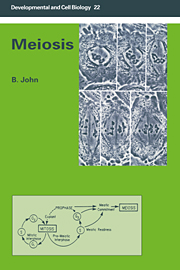Book contents
- Frontmatter
- Contents
- Acknowledgements
- Prologue
- 1 Introduction – multiplication and division
- 2 Modes of meiosis
- 3 Occurrence and timing of meiosis
- 4 Events and mechanisms of meiosis
- 5 Chromosome disjunction
- 6 The genetic control of meiosis
- 7 Sequences and consequences of meiosis
- 8 Evolutionary aspects of meiosis
- Postlogue
- References
- Index
2 - Modes of meiosis
Published online by Cambridge University Press: 21 January 2010
- Frontmatter
- Contents
- Acknowledgements
- Prologue
- 1 Introduction – multiplication and division
- 2 Modes of meiosis
- 3 Occurrence and timing of meiosis
- 4 Events and mechanisms of meiosis
- 5 Chromosome disjunction
- 6 The genetic control of meiosis
- 7 Sequences and consequences of meiosis
- 8 Evolutionary aspects of meiosis
- Postlogue
- References
- Index
Summary
Repetition is the only form of permanence that nature can achieve.
George SantayanaThe essential requirement of meiosis is the regular segregation of homologous chromosomes or chromosome regions. Only in this way is it possible to produce the genetically balanced gametes necessary to sustain development. There are three principal means of achieving such a segregation and these define three rather distinctive modes of meiosis: chiasmate meiosis, achiasmate meiosis and inverted meiosis.
CHIASMATE MEIOSIS
This is the most common category of meiosis and it occurs, and recurs, in a reasonably conserved form, in by far the vast majority of diploid eukaryotes. It thus has high evolutionary stability. Even so, the precise details may differ in diploids and polyploids and between diploids with a structurally homozygous set of chromosomes compared to diploids which are heterozygous for structural chromosome changes.
Meiosis in diploids
As in the mitotic cycle, the replication of the greater part of the genome occurs before the onset of meiosis though, as will become apparent later (see Chapter 4D.2.2), a small amount of replication also occurs during prophase of the first meiotic division.Each chromosome entering meiosis thus consists of two sister chromatids. Unlike the situation in mitosis, however, these are not readily resolvable by light microscopy and it is for this reason that the first substage of prophase-1 is named leptotene.Added to this, individual chromosomes are not distinguishable since they are long and tangled (Fig. 2.1a). The one exception involves the sex chromosomes of many male animals, and especially the single X-chromosome of male orthopterans which is compact and heteropycnotic.
- Type
- Chapter
- Information
- Meiosis , pp. 29 - 102Publisher: Cambridge University PressPrint publication year: 1990
- 1
- Cited by



